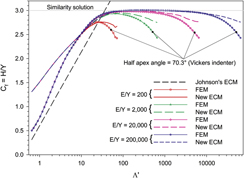Crossref Citations
This article has been cited by the following publications. This list is generated based on data provided by
Crossref.
Kaboli, Shirin
Goldbaum, Dina
Chromik, Richard R.
and
Gauvin, Raynald
2013.
Electron Channeling Contrast Imaging of Plastic Deformation Induced by Indentation in Polycrystalline Nickel.
Microscopy and Microanalysis,
Vol. 19,
Issue. 6,
p.
1620.
Kang, Seung-Kyun
Kim, Young-Cheon
Kim, Kug-Hwan
Kim, Ju-Young
and
Kwon, Dongil
2013.
Extended expanding cavity model for measurement of flow properties using instrumented spherical indentation.
International Journal of Plasticity,
Vol. 49,
Issue. ,
p.
1.
Nikas, George K.
2016.
Algebraic Equations for the Pile-Up Geometry in Debris Particle Indentation of Rolling Elastohydrodynamic Contacts.
Journal of Tribology,
Vol. 138,
Issue. 2,
Midawi, A.R.H.
Simha, C.H.M.
and
Gerlich, A.P.
2016.
Novel techniques for estimating yield strength from loads measured using nearly-flat instrumented indenters.
Materials Science and Engineering: A,
Vol. 675,
Issue. ,
p.
449.
Wang, Z.
Basu, S.
Murthy, T.G.
and
Saldana, C.
2016.
Modified cavity expansion formulation for circular indentation and experimental validation.
International Journal of Solids and Structures,
Vol. 97-98,
Issue. ,
p.
129.
Budnitzki, M.
and
Kuna, M.
2016.
Stress induced phase transitions in silicon.
Journal of the Mechanics and Physics of Solids,
Vol. 95,
Issue. ,
p.
64.
Yuan, Zhanwei
Wang, Yu
Tian, Wenbin
Wang, Yingying
Wang, Kai
Li, Fuguo
Guo, Yajie
Hu, Yongbiao
and
Wang, Xingang
2018.
The relationship between plastic zone and contact radius during indentation experiment for strain-hardened materials.
Philosophical Magazine Letters,
Vol. 98,
Issue. 5,
p.
209.
Zhan, Xuepeng
Wu, Jianjun
Wu, Hongfei
Wang, Mingzhi
Hui, Yu
Shang, Qi
and
Ren, Yinxiang
2018.
A new modified ECM approach on the identification of plastic anisotropic properties by spherical indentation.
Materials & Design,
Vol. 139,
Issue. ,
p.
392.
Wang, Zhiyu
Murthy, Tejas G.
and
Saldana, Christopher
2019.
Deformation field interaction in sequential circular indentation of a strain hardening material.
Philosophical Magazine,
Vol. 99,
Issue. 10,
p.
1259.
An, Lu
Zhang, Di
Zhang, Lin
and
Feng, Gang
2019.
Effect of nanoparticle size on the mechanical properties of nanoparticle assemblies.
Nanoscale,
Vol. 11,
Issue. 19,
p.
9563.
Nikas, George K.
2022.
Approximate analytical solution for the pile-up (lip) profile in normal, quasi-static, elastoplastic, spherical and conical indentation of ductile materials.
International Journal of Solids and Structures,
Vol. 234-235,
Issue. ,
p.
111240.
Yang, Liu
Yang, Duo
Li, Yuxue
Cai, Jiawei
and
Jiang, Xiaoyu
2024.
Nanoindentation study on microscopic mineral mechanics and bedding characteristics of continental shales.
Energy,
Vol. 312,
Issue. ,
p.
133614.
Kim, Jong-hyoung
Kwon, Oh Min
Lee, Junsang
Son, Hae-Jin
Kim, Young-Cheon
and
Kang, Seung-Kyun
2024.
Equivalent-Volume Model: Estimating Contact Morphology of Spherical Indentation for Metallic Materials.
Metals and Materials International,
Vol. 30,
Issue. 3,
p.
714.
Sevastyanov, Georgiy M.
2024.
New expanding cavity model for conical indentation and its application to determine an intrinsic length scale of polymeric materials.
Acta Mechanica,
Vol. 235,
Issue. 7,
p.
4229.
Kim, Jong-hyoung
Lee, Kyungyul
Kwon, Dongil
and
Schajer, Gary S.
2025.
Evaluation of Non-equi-biaxial Residual Stresses from the Surface Displacements Around a Single Indentation.
Metals and Materials International,



